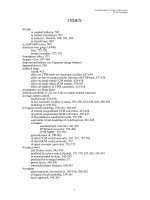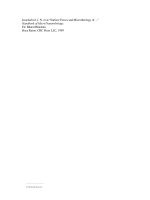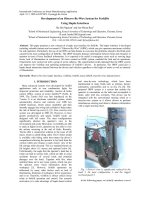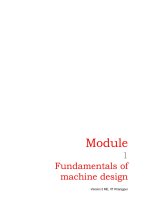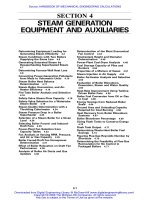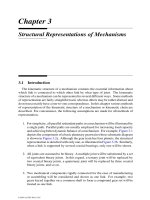Tài liệu Pronunciation of mathematical expressions pptx
Bạn đang xem bản rút gọn của tài liệu. Xem và tải ngay bản đầy đủ của tài liệu tại đây (82.08 KB, 3 trang )
17.2.1999/H. V¨aliaho
Pronunciation of mathematical expressions
The pronunciations of the most common mathematical expressions are given in the list
below. In general, the shortest versions are preferred (unless greater precision is necessary).
1. Logic
∃ there exists
∀ for all
p ⇒ q p implies q / if p, then q
p ⇔ q p if and only if q /p is equivalent to q / p and q are equivalent
2. Sets
x ∈ A x belongs to A / x is an element (or a member) of A
x /∈ A x does not belong to A / x is not an element (or a member) of A
A ⊂ B A is contained in B / A is a subset of B
A ⊃ B A contains B / B is a subset of A
A ∩ B A cap B / A meet B / A intersection B
A ∪ B A cup B / A join B / A union B
A \ B A minus B / the difference between A and B
A × B A cross B / the cartesian product of A and B
3. Real numbers
x + 1 x plus one
x − 1 x minus one
x ± 1 x plus or minus one
xy xy / x multiplied by y
(x − y)(x + y) x minus y, x plus y
x
y
x over y
= the equals sign
x = 5 x equals 5 / x is equal to 5
x = 5 x (is) not equal to 5
1
x ≡ y x is equivalent to (or identical with) y
x ≡ y x is not equivalent to (or identical with) y
x > y x is greater than y
x ≥ y x is greater than or equal to y
x < y x is less than y
x ≤ y x is less than or equal to y
0 < x < 1 zero is less than x is less than 1
0 ≤ x ≤ 1 zero is less than or equal to x is less than or equal to 1
|x| mod x / modulus x
x
2
x squared / x (raised) to the power 2
x
3
x cubed
x
4
x to the fourth / x to the power four
x
n
x to the nth / x to the power n
x
−n
x to the (power) minus n
√
x (square) root x / the square root of x
3
√
x cube root (of) x
4
√
x fourth root (of) x
n
√
x nth root (of) x
(x + y)
2
x plus y all squared
x
y
2
x over y all squared
n! n factorial
ˆx x hat
¯x x bar
˜x x tilde
x
i
xi / x subscript i / x suffix i / x sub i
n
i=1
a
i
the sum from i equals one to n a
i
/ the sum as i runs from 1 to n of the a
i
4. Linear algebra
x the norm (or modulus) of x
−−→
OA OA / vector OA
OA OA / the length of the segment OA
A
T
A transpose / the transpose of A
A
−1
A inverse / the inverse of A
2
5. Functions
f(x) fx / f of x / the function f of x
f : S → T a function f from S to T
x → y x maps to y / x is sent (or mapped) to y
f
(x) f prime x / f dash x / the (first) derivative of f with respect to x
f
(x) f double–prime x / f double–dash x / the second derivative of f with
respect to x
f
(x) f triple–prime x / f triple–dash x / the third derivative of f with respect
to x
f
(4)
(x) f four x / the fourth derivative of f with respect to x
∂f
∂x
1
the partial (derivative) of f with respect to x
1
∂
2
f
∂x
2
1
the second partial (derivative) of f with respect to x
1
∞
0
the integral from zero to infinity
lim
x→0
the limit as x approaches zero
lim
x→+0
the limit as x approaches zero from above
lim
x→−0
the limit as x approaches zero from below
log
e
y log y to the base e / log to the base e of y / natural log (of) y
ln y log y to the base e / log to the base e of y / natural log (of) y
Individual mathematicians often have their own way of pronouncing mathematical expres-
sions and in many cases there is no generally accepted “correct” pronunciation.
Distinctions made in writing are often not made explicit in speech; thus the sounds fx may
be interpreted as any of: fx, f(x), f
x
, FX,
F X,
−−→
F X . The difference is usually made clear
by the context; it is only when confusion may occur, or where he/she wishes to emphasise
the point, that the mathematician will use the longer forms: f multiplied by x, the function
f of x, f subscript x, line F X, the length of the segment F X, vector F X.
Similarly, a mathematician is unlikely to make any distinction in speech (except sometimes
a difference in intonation or length of pauses) between pairs such as the following:
x + (y + z) and (x + y) + z
√
ax + b and
√
ax + b
a
n
− 1 and a
n−1
The primary reference has been David Hall with Tim Bowyer, Nucleus, English for Science
and Technology, Mathematics, Longman 1980. Glen Anderson and Matti Vuorinen have
given good comments and supplements.
3

